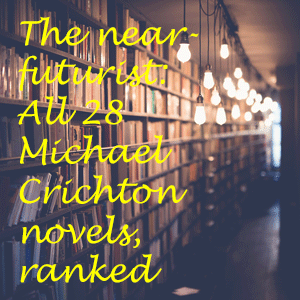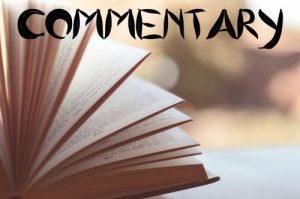I’ve been doing occasional “Star Wars Flashback” entries, but I thought I’d take a break here and give a rundown of my top 10 “Star Wars” novelists. For geeks like me, it might provide a good debate; for newcomers, I outline the strengths of each author and select their best book.
1. Karen Traviss (10 novels, 2004-09) — Traviss explores the questions of what it’s like to be a clone grown in a vat, trained to follow orders and serve the Republic, with no family except your millions of brothers. Also, she tackles the science — is there a way to slow down the accelerated aging process so a clone can live as a normal human? She nicely gives heft to these initially (literally) stock characters by tying them in with the honorable/mercenary Mandalorian culture of their template, Jango Fett. And she also gets good mileage out of romantically pairing a clone and a Jedi — both from groups that forbid attachment. Although she makes nice use of her military expertise, her biggest strength is character interaction and genuine conversations. “The Clone Wars” TV series has picked up the themes of Traviss’ work, but not given them as much depth. Sadly, with the TV series providing a contradictory view of Mandalore, Traviss bowed out of “Star Wars” writing just as her exploration of clones in the post-“Clone Wars” era was starting to ratchet up.
Best novel: “Republic Commando: Hard Contact” (2004). Based on a game that’s ironically less-beloved than the novels, this is where it all begins.
2. Aaron Allston (13 novels, 1998-2012) — Currently the most prolific “Star Wars” author among the adult novels, Allston did a remarkable thing when taking the reins of the “X-Wing” series from Michael Stackpole: He made the series even better. Similar to Traviss, he’s able to take non-movie characters and make us care deeply about them. The death of a Wraith Squadron member, and his best friend’s reaction to it, in one of his early works is one of the best “Star Wars” death scenes ever written. However, as much as danger features heavily in his novels — many of which chronicle the Wraiths, a group of pilots who can also do undercover infiltrations — Allston is so good with natural banter and humor between characters that his work puts a smile on my face more often than any other “Star Wars” author.
Best novel: “X-Wing: Starfighters of Adumar” (1999). Although it’s the ninth book in the series, it’s a rip-roaring standalone yarn.
3. Timothy Zahn (10 novels, 1991-2013) — No other Expanded Universe author has invented more iconic characters; his contributions include Mara Jade, Talon Karrde and Grand Admiral Thrawn, and technically, Jacen and Jaina Solo (although the latter two would become full-fledged characters elsewhere). Resurrecting “Star Wars” fiction from the dark days with the richly plotted yet fast-paced “Heir to the Empire” in 1991, Zahn thrilled us with returns to old planets like Dagobah and introductions of new ones that immediately seemed like a part of the “Star Wars” universe we just hadn’t gotten around to visiting yet. Heck, the galaxy proper wasn’t even big enough to contain his imagination, as he also gave us “Survivor’s Quest” (2004) and its prequel “Outbound Flight” (2006), using a throwaway idea from the Thrawn trilogy to tie together two generations of the saga.

Best novel: “Dark Force Rising” (1992). Although, looking at the cover featuring Han, Chewie and Lando in a police lineup, “Scoundrels,” scheduled for a Jan. 1 release, could be my new favorite.
4. Matthew Stover (four novels, 2002-08) — Stover, quite simply, saved “Revenge of the Sith.” Taking a movie that was a bit uneven but filled with big ideas, Stover essentially set out to make sense of what was going on in the heads of the characters (particularly Anakin Skywalker), and he delivered what is by far the best of the six novelizations, despite the fact that he was working from what I think is the weakest movie. Getting into a character’s head is Stover’s strength, although you have to be willing to wade into some darkness first, as is the case with the Jacen Solo piece “Traitor” (2002) and the Mace Windu exploration “Shatterpoint” (2003). “Luke Skywalker and the Shadows of Mindor” (2008) is lighter, but it’s still one of the best Luke-centered books.
Best novel: “Revenge of the Sith” (2005).
5. A.C. Crispin (three novels, 1997-98) — In the “Star Wars” fold, her bibliography makes her seem like a one-note author. However, that one note is the backstory of Han Solo, as chronicled in “The Paradise Snare,” “The Hutt Gambit” and “Rebel Dawn.” Although Crispin wasn’t allowed to chronicle the first meeting of Han and Chewie, we see how Han’s affection for Wookiees came to be (he was essentially raised by one); we also get his early interactions with Lando; and perhaps coolest of all, his one true relationship before Leia, in the form of fledgling Rebel Bria Tharen.
Best novel: It’s been a while since I’ve read these (don’t worry — they are on my re-reading list), but if memory serves, the conclusive “Rebel Dawn” (1998) is the best, as it brings many plot elements to a head and eventually deposits our hero in the cantina just in time for his movie debut.
6. James Luceno (eight novels, 2000-12) — Luceno came into the “Star Wars” fold with fans ready to love him: We knew him as being a good friend and collaborator with the late Brian Daley, author of the Han Solo Adventures trilogy. With his first entry, “Agents of Chaos I: Hero’s Trial,” Luceno effectively (and no doubt deliberately) captured that old-school, adventurous Daley vibe. I liked Han’s new sidekick, Droma, so much that I hoped he’d become a main character (alas, it wasn’t to be). Wayne from The Star Wars Book Report podcast described Luceno nicely: He’s the author Lucas Books trusts most, and that’s reflected in his catalog. He wrote the book that concludes 19-part “New Jedi Order,” the book that leads into “The Phantom Menace,” the book that leads into “Revenge of the Sith,” the first Anakin Skywalker novel after he becomes Darth Vader, the book that explores the Millennium Falcon’s history, and the book that reveals the backstory of Darth Sidious and his master, Darth Plagueis. Yet he doesn’t play it safe; there’s a lot of spirit and inventiveness in his writing.
Best novel: “Darth Plagueis” (2012).
7. Michael Stackpole (eight novels, 1996-2000) — Stackpole bravely launched the “X-Wing” series at a time when stories about characters other than Luke, Han and Leia were considered to be risky (although they had proven successful in the comic-book medium with “Tales of the Jedi”). I remember it took me a year or so to finally pick up the first book, “Rogue Squadron,” because I feared it would be a bunch of space dogfights (or even worse, simulated space dogfights, which is indeed how the first book starts off). However, the starfighter jocks’ personalities soon start to pop, and the major plot ends up being crucial to the galaxy at large — the Rogues are central to the mission to capture Coruscant (which is still under Imperial rule at the end of “Return of the Jedi.”)
Best novel: “I, Jedi” (1998). In this unique novel, Corran Horn tells his tale in the first person, and we see many events from Kevin J. Anderson’s “Jedi Academy” trilogy from a fresh perspective.
8. Michael Reaves (nine novels, 2001-13) — Reaves has carved out a nice little niche for himself amidst George Lucas’ sandbox by chronicling Jax Pavan, who will be the title character of “The Last Jedi,” set for release next spring. Jax’s story goes all the way back to the tale of his dad fleeing from Darth Maul in 2001’s “Darth Maul: Shadow Hunter.” Reaves delivers one of the few, and one of the best sci-fi threads of the Expanded Universe via the character of I-Five, a droid who acts human and often provides a self-analysis of what makes him more “human” than other droids. Although Reaves has collaborated with other writers (Steve Perry and Maya Kaathryn Bohnhoff), I tend to give him credit for those books (and I blame his co-writer for the missteps) because I’ve also read his successful solo work.
Best books: The “MedStar” duology, “Battle Surgeons” and “Jedi Healer” (2004), co-written with Perry. Don’t let the titles scare you away (as they almost did for me); these aren’t “ER in Space.”
Trivia: Reaves’ involvement with “Star Wars” actually dates back to 1985, but his first contributions were in TV, not books. He wrote one episode of “Droids” and two episodes of “Ewoks.”
9. Brian Daley (three novels, 1979-80) — Daley (1947-96) only had Han, Chewie and the Falcon to work with in “Han Solo at Stars’ End,” “Han Solo’s Revenge” and “Han Solo and the Lost Legacy”; he wasn’t allowed to play with the larger political background of the Empire (thus he invented the Corporate Sector, which still pops up in new “Star Wars” stories), nor could he explore details of Han and Chewie’s backgrounds. The limited canvas didn’t pose a problem though, as Daley absolutely nails the adventurous spirit of vintage “Star Wars,” the edge-of-the-law lifestyle of smugglers, and these two characters in particular. These books are “Star Wars” done as dime-store novels, and I mean that as a compliment. (Of course, fans know that Daley was allowed to sink his teeth more deeply into the saga with the three radio dramas.)
Best novel: “Han Solo’s Revenge” (1979).
Trivia: Daley wrote the plot for the “Droids: The Protocol Offensive” comic book (1997). C-3PO actor Anthony Daniels then co-wrote the script.
10. John Jackson Miller (two novels, 2011-12) — Although Zahn and Stackpole have impressive comic-book resumes, Miller is the author on this list who is most clearly a comic writer first and a novelist second, as his “Knights of the Old Republic” comics are fan favorites and his current “Knight Errant” work shows an even more deft touch with characters. He makes this list because he’s proven to be a talented storyteller through novels as well. Drawing from his world history expertise, he carved out a compelling Sith vs. Jedi portion of the galaxy in “Knight Errant” (2011), but it was his “Lost Tribe of the Sith” from earlier this year that really impressed me — it’s a sprawling nine-part saga that was originally published in e-book form, except for the final installment. Miller makes a single planet, Kesh, so fascinating that you don’t even feel like you’re missing anything from the galaxy at large. (Not surprisingly, “Lost Tribe of the Sith” has since branched into comics as well.)
Best novel: “Lost Tribe of the Sith” (2012).
Any snubs you’d like to call me out on? And what are your rankings of the 10 best “Star Wars” authors? Share your thoughts in the comment thread below.

